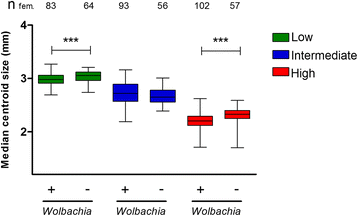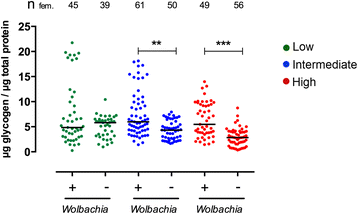The influence of larval competition on Brazilian Wolbachia-infected Aedes aegypti mosquitoes
- PMID: 27183820
- PMCID: PMC4869337
- DOI: 10.1186/s13071-016-1559-5
The influence of larval competition on Brazilian Wolbachia-infected Aedes aegypti mosquitoes
Abstract
Background: With field releases starting in Brazil, particular interest must be given to understanding how the endosymbiotic bacterium Wolbachia pipientis affects Aedes aegypti mosquitoes with a Brazilian genetic background. Currently, there is limited information on how the bacterium affects phenotypic traits such as larval development rate, metabolic reserves and morphometric parameters in Ae. aegypti. Here, we analyze for the first time, the effect of Wolbachia on these key phenotypes and consider how this might impact the potential of the bacterium as a disease control agent in Brazil.
Methods: We examined the influence of the wMel strain of Wolbachia in laboratory Ae. aegypti with a Brazilian genetic background, reared under different larval densities. Pupae formation was counted daily to assess differences in development rates. Levels of metabolic reserves and morphometric parameters were assessed in adults resulting from each larval condition.
Results: wMel infection led to more rapid larval development at higher densities for both males and females, with no effect under less crowded conditions in females. Infection also led to reduced body size at both high and low density, but not at intermediate density, although the scale of this difference was maintained regardless of larval density, in comparison to uninfected individuals. Wing shape also varied significantly between infected and uninfected mosquitoes due to larval density. Glycogen levels in uninfected mosquitoes decreased under higher larval density, but were consistently high with Wolbachia infection, regardless of larval density.
Conclusions: We demonstrate that the wMel Wolbachia strain can positively influence some important host fitness traits, and that this interaction is directly linked to the conditions in which the host is reared. Combined with previously published data, these results suggest that this Wolbachia strain could be successfully used as part of the Eliminate Dengue Program in Brazil.
Keywords: Aedes aegypti; Development time; Glycogen; Larval competition; Morphometrics; Wolbachia.
Figures






Similar articles
-
How does competition among wild type mosquitoes influence the performance of Aedes aegypti and dissemination of Wolbachia pipientis?PLoS Negl Trop Dis. 2017 Oct 9;11(10):e0005947. doi: 10.1371/journal.pntd.0005947. eCollection 2017 Oct. PLoS Negl Trop Dis. 2017. PMID: 28991902 Free PMC article.
-
From lab to field: the influence of urban landscapes on the invasive potential of Wolbachia in Brazilian Aedes aegypti mosquitoes.PLoS Negl Trop Dis. 2015 Apr 23;9(4):e0003689. doi: 10.1371/journal.pntd.0003689. eCollection 2015 Apr. PLoS Negl Trop Dis. 2015. PMID: 25905888 Free PMC article.
-
Larval competition extends developmental time and decreases adult size of wMelPop Wolbachia-infected Aedes aegypti.Am J Trop Med Hyg. 2014 Jul;91(1):198-205. doi: 10.4269/ajtmh.13-0576. Epub 2014 Apr 14. Am J Trop Med Hyg. 2014. PMID: 24732463 Free PMC article.
-
Wolbachia-mediated virus blocking in the mosquito vector Aedes aegypti.Curr Opin Insect Sci. 2017 Aug;22:37-44. doi: 10.1016/j.cois.2017.05.005. Epub 2017 May 10. Curr Opin Insect Sci. 2017. PMID: 28805637 Review.
-
Mission Accomplished? We Need a Guide to the 'Post Release' World of Wolbachia for Aedes-borne Disease Control.Trends Parasitol. 2018 Mar;34(3):217-226. doi: 10.1016/j.pt.2017.11.011. Epub 2018 Jan 23. Trends Parasitol. 2018. PMID: 29396201 Review.
Cited by
-
How does competition among wild type mosquitoes influence the performance of Aedes aegypti and dissemination of Wolbachia pipientis?PLoS Negl Trop Dis. 2017 Oct 9;11(10):e0005947. doi: 10.1371/journal.pntd.0005947. eCollection 2017 Oct. PLoS Negl Trop Dis. 2017. PMID: 28991902 Free PMC article.
-
Wolbachia's Deleterious Impact on Aedes aegypti Egg Development: The Potential Role of Nutritional Parasitism.Insects. 2020 Oct 27;11(11):735. doi: 10.3390/insects11110735. Insects. 2020. PMID: 33120915 Free PMC article. Review.
-
Native Wolbachia infection and larval competition stress shape fitness and West Nile virus infection in Culex quinquefasciatus mosquitoes.Front Microbiol. 2023 Mar 15;14:1138476. doi: 10.3389/fmicb.2023.1138476. eCollection 2023. Front Microbiol. 2023. PMID: 37007535 Free PMC article.
-
Competition among Aedes aegypti larvae.PLoS One. 2018 Nov 15;13(11):e0202455. doi: 10.1371/journal.pone.0202455. eCollection 2018. PLoS One. 2018. PMID: 30439951 Free PMC article.
-
Control of arboviruses vectors using biological control by Wolbachia pipientis: a short review.Arch Microbiol. 2022 Jun 9;204(7):376. doi: 10.1007/s00203-022-02983-x. Arch Microbiol. 2022. PMID: 35678877
References
-
- World Health Organization . WHO | Global Strategy for dengue prevention and control, 2012–2020. Geneva: World Health Organization; 2012.
Publication types
MeSH terms
LinkOut - more resources
Full Text Sources
Other Literature Sources
Medical

